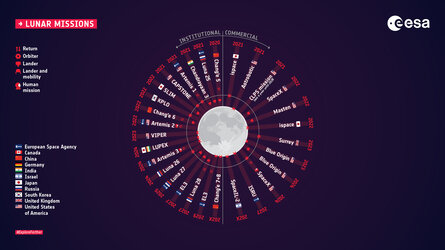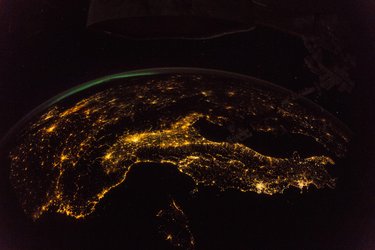Accept all cookies Accept only essential cookies See our Cookie Notice

About ESA
The European Space Agency (ESA) is Europe’s gateway to space. Its mission is to shape the development of Europe’s space capability and ensure that investment in space continues to deliver benefits to the citizens of Europe and the world.
Highlights
ESA - United space in Europe
This is ESA ESA facts Member States & Cooperating States Funding Director General Top management For Member State Delegations European vision European Space Policy ESA & EU Space Councils Responsibility & Sustainability Annual Report Calendar of meetings Corporate newsEstablishments & sites
ESA Headquarters ESA ESTEC ESA ESOC ESA ESRIN ESA EAC ESA ESAC Europe's Spaceport ESA ESEC ESA ECSAT Brussels Office Washington OfficeWorking with ESA
Business with ESA ESA Commercialisation Gateway Law at ESA Careers Cyber resilience at ESA IT at ESA Newsroom Partnerships Merchandising Licence Education Open Space Innovation Platform Integrity and Reporting Administrative Tribunal Health and SafetyMore about ESA
History ESA Historical Archives Exhibitions Publications Art & Culture ESA Merchandise Kids Diversity ESA Brand Centre ESA ChampionsLatest
Space in Member States
Find out more about space activities in our 23 Member States, and understand how ESA works together with their national agencies, institutions and organisations.
Science & Exploration
Exploring our Solar System and unlocking the secrets of the Universe
Go to topicAstronauts
Missions
Juice Euclid Webb Solar Orbiter BepiColombo Gaia ExoMars Cheops Exoplanet missions More missionsActivities
International Space Station Orion service module Gateway Concordia Caves & Pangaea BenefitsLatest
Space Safety
Protecting life and infrastructure on Earth and in orbit
Go to topicAsteroids
Asteroids and Planetary Defence Asteroid danger explained Flyeye telescope: asteroid detection Hera mission: asteroid deflection Near-Earth Object Coordination CentreSpace junk
About space debris Space debris by the numbers Space Environment Report In space refuelling, refurbishing and removingSafety from space
Clean Space ecodesign Zero Debris Technologies Space for Earth Supporting Sustainable DevelopmentApplications
Using space to benefit citizens and meet future challenges on Earth
Go to topicObserving the Earth
Observing the Earth Future EO Copernicus Meteorology Space for our climate Satellite missionsCommercialisation
ESA Commercialisation Gateway Open Space Innovation Platform Business Incubation ESA Space SolutionsLatest
Enabling & Support
Making space accessible and developing the technologies for the future
Go to topicBuilding missions
Space Engineering and Technology Test centre Laboratories Concurrent Design Facility Preparing for the future Shaping the Future Discovery and Preparation Advanced Concepts TeamSpace transportation
Space Transportation Ariane Vega Space Rider Future space transportation Boost! Europe's Spaceport Launches from Europe's Spaceport from 2012Latest

Overview of an overview
Thank you for liking
You have already liked this page, you can only like it once!
Spaceflight affects not only the body but also the mind. Viewing Earth from space day in and out for six months is bound to change a human’s perspective on Earth’s future in our Galaxy.
Living on Earth it is easy to find it rich, vast, and powerful. However, seeing Earth suspended in the void of space with just a thin protective layer shielding all its inhabitants from cosmic radiation, extreme temperatures, and flying projectiles, our mothership suddenly seems so fragile.
This cognitive shift is known as the overview effect that many astronauts report during and after spaceflight. It is an awareness brought on by countless hours of Earth viewing and the photographs taken, like this image captured by ESA astronaut Alexander Gerst from the International Space Station in November 2018, that shows just how thin Earth’s shield, our atmosphere, really is.
It is hard to measure the thickness of our atmosphere, as it becomes thinner with increasing altitude. Though there is no definitive boundary line between it and outer space, atmospheric effects become noticeable when spacecraft reenter Earth at an altitude of 120 km.
Regardless, it is the product of billions of years of biochemical change by the countless organisms able to survive on Earth thanks to this protective layer.
However, should life on Earth continue in its industrial-era tracks, the threats to our planet are internal. Unchecked human consumption of natural resources is causing global temperatures to rise. The resulting change in climate is wreaking havoc on natural habitats and leading to major weather events.
ESA’s Earth observation satellites, along with astronauts from the International Space Station, are witnesses to this global crisis and continue to provide us with data and imagery to inspire action.
This week representatives from almost 200 countries have gathered in Katowice, Poland for the 24th conference of the Parties (COP24) of the United Nations Framework Convention on Climate Change.
One of the most important tasks at the summit is to agree the course of action to implement the 2015 Paris Agreement – and, with the 2°C target now deemed not enough, to coordinate an international effort to halt warming at 1.5°C.
The meeting focuses on a triangle of nature, man and technology, and will investigate how they can be used to reduce climate change and mitigate its effects.
This will take determined and coordinated international effort to help protect our planet. In the meantime, astronauts will continue to share this overview to inspire action.
-
CREDIT
ESA/NASA -
LICENCE
ESA Standard Licence

Lunar missions overview

Mares machine

Alexander during emergency training on the Space Station

Mapping the night















 Germany
Germany
 Austria
Austria
 Belgium
Belgium
 Denmark
Denmark
 Spain
Spain
 Estonia
Estonia
 Finland
Finland
 France
France
 Greece
Greece
 Hungary
Hungary
 Ireland
Ireland
 Italy
Italy
 Luxembourg
Luxembourg
 Norway
Norway
 The Netherlands
The Netherlands
 Poland
Poland
 Portugal
Portugal
 Czechia
Czechia
 Romania
Romania
 United Kingdom
United Kingdom
 Slovenia
Slovenia
 Sweden
Sweden
 Switzerland
Switzerland

























